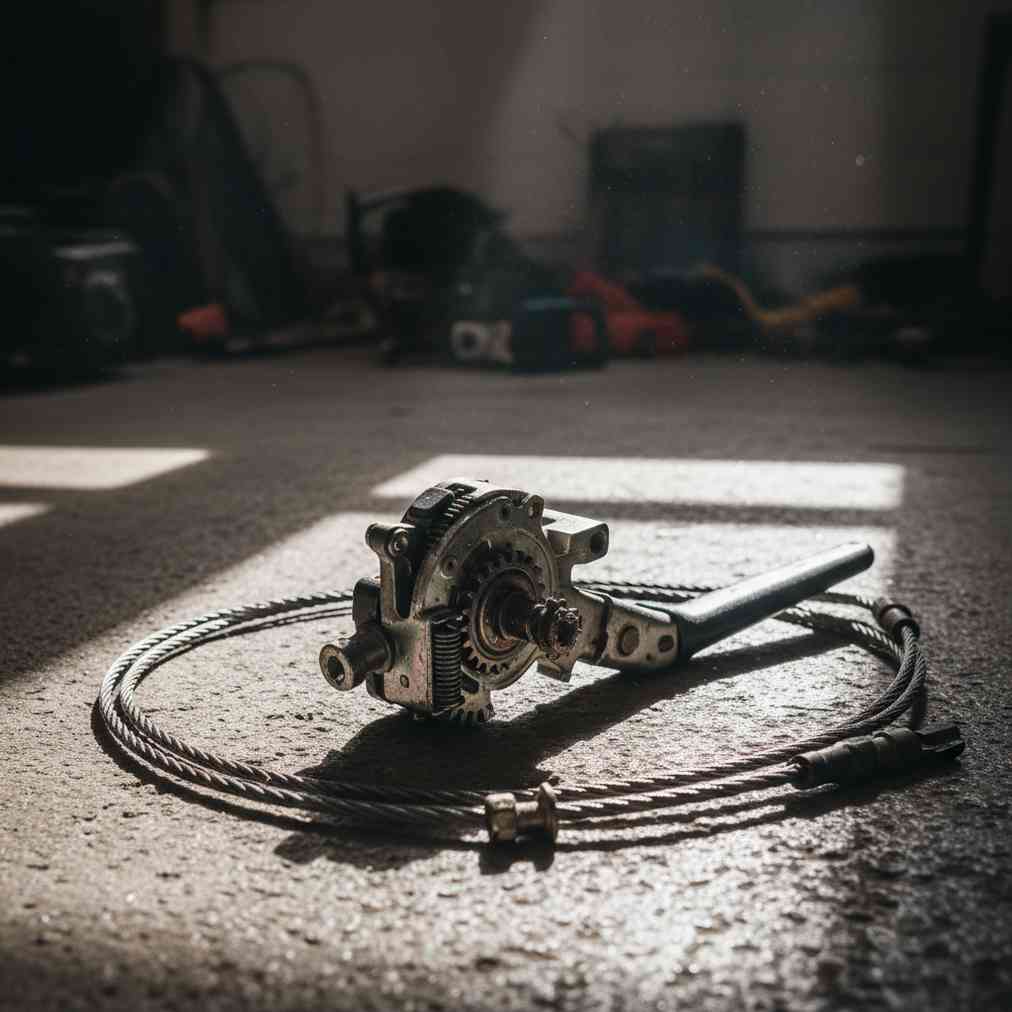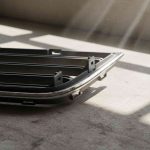Understanding Parking Brake System Parts
A traditional mechanical parking brake system operates independently of your vehicle’s main hydraulic braking system, relying on mechanical linkage to secure the rear wheels. When sourcing a used parking brake assembly from a salvage yard, understanding the key parts is essential for a successful purchase.
Primary Parts of a Parking Brake System
- Brake Operating Mechanism: Hand lever (handbrake), foot pedal, or electronic button (EPB)
- Cables: Primary cable from lever to relay lever, splitting into two separate cables for each rear wheel
- Brake Unit: Direct braking force application at rear wheels
- Rear Calipers/Drums: Hardware that works with parking brake cables
The brake unit varies by vehicle type and includes disc integrated parking brakes with shoes and levers inside the rotor assembly, drum integrated systems using existing brake shoes, or central brake types installed behind the transmission. When visiting junkyards near me, you’ll primarily search for the lever/pedal assembly, complete parking brake cables, and rear brake hardware.
Inspecting Used Parking Brake Cables
Parking brake cables are the most common wear item in mechanical systems, as they stretch, corrode, and seize over time. Thorough inspection is crucial when sourcing from salvage yards to ensure you’re getting functional parts that will provide reliable service.
| Inspection Point | How to Check | What to Look For |
|---|---|---|
| Fraying/Damage | Visually inspect entire exposed cable length | Broken strands, kinking, or damaged outer sheath |
| Rust/Corrosion | Check cable entry/exit points near axle and frame | Rust bubbles or visible rust through sheath |
| Stretching/Slack | Engage brake fully and check adjuster position | Excessive pulls needed or maxed out adjuster |
| Binding/Seizing | Manually manipulate cable ends and inner core | Sticking, binding, or poor retraction |
Pro Tip: If the cable is seized where it connects to the rear caliper, disconnect it at the lever inside the cabin first, then trace and disconnect at the rear. Patience prevents breakage of valuable parts.
Testing Cable Functionality
When possible, perform functional tests on the parking brake cables. A properly functioning cable should retract completely into its outer casing when the brake is fully released. If you notice the cable appears loose or the adjuster is at maximum extension, the cable has likely stretched beyond useful limits.
Understanding data analysis techniques can help you make informed decisions about part condition based on visual and functional inspection results.
Complete Hardware Removal Checklist
Successfully obtaining a complete used parking brake assembly requires more than just the main lever and cables. Missing small clips, brackets, or hardware pieces can make reinstallation difficult and compromise safety. Use this comprehensive checklist to ensure you gather all necessary parts.
Actuator and Wheel End Parts
| Part Group | Checklist Item | Salvage Yard Notes |
|---|---|---|
| Brake Hardware | Parking brake shoes/pads | Ensure shoes and actuator lever are present for drum-in-disc style |
| Mounting Hardware | Caliper/wheel cylinder bracket | Include entire caliper or specific parking brake actuator arm |
| Small Hardware | C-clips, pins, and struts | These hold parking brake shoes in place and are often non-reusable |
| Adjustment | Adjuster mechanism | Look for nut/bolt assembly near lever or under floor |
Cable Run and Mounting Hardware
- Cable clips and mounts: Collect all metal clips, brackets, and insulators securing cable housing to frame
- Cable grommets and seals: Rubber grommets where cables pass through floor pan or firewall
- Protective covers: Heat shields or protective sleeves along the cable run
- Adjustment hardware: Nuts, bolts, and tensioning devices
Many salvage yards like those found through LKQ Pick Your Part Houston organize parts systematically, making it easier to locate complete assemblies with all necessary hardware intact.
Operating Mechanism Parts
The operating mechanism varies significantly between vehicles but typically includes the main lever or pedal assembly, mounting hardware, and internal adjustment components. For Electronic Parking Brake (EPB) systems, you’ll need the activation button, control unit, and electric motors attached to rear brake elements.
- Lever/pedal assembly with handle and mounting bolts
- Internal adjustment nuts and springs
- All mounting bolts, nuts, and washers
- Electrical connections (for EPB systems)
Special Considerations for Different Systems
Modern vehicles may feature electronic parking brake systems that differ significantly from traditional mechanical setups. These systems require different parts and inspection techniques when sourcing from salvage yards.
Electronic Parking Brake Systems
EPB systems eliminate traditional cables in favor of electronic controls and electric motors. When sourcing these systems, ensure you obtain:
- Electronic control module
- Activation switch or button
- Electric actuator motors
- Wiring harnesses and connectors
- Brake caliper integration hardware
Cable inspection becomes less relevant for EPB systems, but verifying the integrity of electronic parts and motor assemblies is crucial. If you’re selling a vehicle with EPB issues, consider getting an instant quote for junk car to determine if repair or replacement makes financial sense.
Finding Quality Used Parking Brake Assemblies
Locating the right used parking brake assembly requires research and patience. Start by identifying your vehicle’s specific system type and required parts before visiting salvage yards.
Research Before You Go
- Identify your vehicle’s parking brake system type
- Create a parts list with OEM part numbers when possible
- Check salvage yard inventory systems online
- Call ahead to verify part availability
- Bring proper tools for removal
Many successful salvage yard visits begin with thorough preparation. Understanding your specific needs and having the right tools can save significant time and ensure you get complete, functional assemblies.
Removal Tips and Techniques
Proper removal technique preserves part integrity and ensures you get all necessary hardware. Start with the operating mechanism inside the vehicle, then work your way to the rear wheels, carefully documenting cable routing and hardware placement.
Take photos during disassembly to reference proper installation procedures and hardware placement when installing your used parts.
For comprehensive guidance on automotive research methods and analysis, research methodology resources can provide valuable insights into systematic approaches for evaluating used auto parts.
Cost Considerations and Value Assessment
Used parking brake assemblies typically cost 60-80% less than new OEM parts, making them attractive options for budget-conscious repairs. However, proper evaluation ensures you get good value for your investment.
Price Factors to Consider
- Part condition and completeness
- Vehicle make, model, and year
- System type (mechanical vs. electronic)
- Local salvage yard pricing policies
- Installation complexity and additional parts needed
Remember that incomplete assemblies may seem cheaper initially but can cost more when you factor in missing hardware and additional trips to source remaining parts. Investing in a complete, quality assembly often provides better long-term value.
Installation and Safety Considerations
Installing a used parking brake assembly requires attention to detail and adherence to safety procedures. Parking brakes are critical safety systems that must function properly to prevent vehicle rollaway accidents.
Post-Installation Testing
After installation, thoroughly test the parking brake system to ensure proper operation. This includes checking adjustment, verifying cable routing, and confirming the system holds the vehicle securely on an incline.
- Test parking brake engagement and release
- Verify proper cable adjustment and tension
- Check for binding or unusual resistance
- Confirm system holds vehicle on moderate incline
- Inspect all connections and mounting points
Professional installation may be advisable for complex systems or if you’re uncomfortable with brake system work. The safety implications of parking brake failure make proper installation critical for vehicle and occupant safety.
With careful inspection, proper part selection, and attention to installation details, a used parking brake assembly can provide reliable service at a fraction of new part costs. Take time to thoroughly evaluate parts before purchase and don’t hesitate to walk away from questionable assemblies that might compromise safety or reliability.





Leave a Reply
You must be logged in to post a comment.